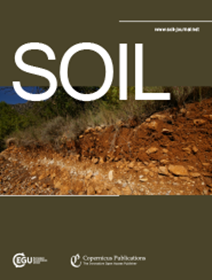土壤是全球温室气体排放和气候变化的主要贡献者
IF 4.3
2区 农林科学
Q1 SOIL SCIENCE
引用次数: 0
摘要
摘要。毫无疑问,人类活动增加了温室气体的排放,这导致了气候变暖,而这些变化在几个世纪到几千年内都是不可逆转的。虽然以前的研究已经广泛地研究了农业或土地利用变化对人为温室气体排放的贡献,但土壤本身的贡献仍然不清楚,量化土壤在这方面的贡献对于制定和实施适当的管理措施至关重要。在本研究中,我们使用先前发表的二氧化碳、氧化亚氮和甲烷数据集来确定基于土壤的温室气体排放及其对人为温室气体排放的贡献。我们表明,我们几乎完全依赖土壤来生产人类所需的快速增长的食物,这导致土壤释放出大量的温室气体,威胁着未来的气候。事实上,仅土壤的人为净排放就占了由混合良好的温室气体引起的全球气候变暖(辐射强迫)增量的15%,其中二氧化碳是土壤排放的最重要气体(占土壤源变暖总量的74%),其次是一氧化二氮(17%)和甲烷(9%)。目前迫切需要防止进一步的土地利用变化(包括生物燃料生产),以限制土壤有机碳损失导致的二氧化碳的释放,制定提高氮肥效率的战略,以减少一氧化二氮的排放,减少稻田的甲烷排放,并确保避免永久冻土的广泛融化。如果我们要将全球变暖限制在1.5°C或2.0°C,就迫切需要创新的方法来减少土壤中的温室气体排放。本文章由计算机程序翻译,如有差异,请以英文原文为准。
Soil is a major contributor to global greenhouse gas emissions and climate change
Abstract. It is unequivocal that human activities have increased emissions of greenhouse gases, that this is causing warming, and that these changes will be irreversible for centuries to millennia. Whilst previous studies have broadly examined the contribution of agriculture or land use change to anthropogenic greenhouse gas emissions, the contribution of soil itself remains unclear, with quantifying the contribution of soil in this regard being critical for developing and implementing appropriate management practices. In the present study, we used previously published datasets for carbon dioxide, nitrous oxide, and methane to determine soil-based emissions of greenhouse gases and their contribution to anthropogenic greenhouse gas emissions. We show that our near-complete reliance on soil to produce the rapidly increasing quantities of food being demanded by humans has caused soil to release profound amounts of greenhouse gases that are threatening the future climate. Indeed, net anthropogenic emissions from soil alone account for 15 % of the entire global increase in climate warming (radiative forcing) caused by well-mixed greenhouse gases, with carbon dioxide being the most important gas emitted from soil (74 % of total soil-derived warming), followed by nitrous oxide (17 %) and methane (9 %). There is an urgent need to prevent further land use change (including for biofuel production) to limit the release of carbon dioxide that results from the loss of soil organic carbon, to develop strategies to increase nitrogen fertilizer efficiency in order to reduce nitrous oxide emissions, to decrease methane from rice paddies, and to ensure that the widespread thawing of permafrost is avoided. Innovative approaches are urgently required for reducing greenhouse gas emissions from soil if we are to limit global warming to 1.5 or 2.0 °C.
求助全文
通过发布文献求助,成功后即可免费获取论文全文。
去求助
来源期刊

Soil
Agricultural and Biological Sciences-Soil Science
CiteScore
10.80
自引率
2.90%
发文量
44
审稿时长
30 weeks
期刊介绍:
SOIL is an international scientific journal dedicated to the publication and discussion of high-quality research in the field of soil system sciences.
SOIL is at the interface between the atmosphere, lithosphere, hydrosphere, and biosphere. SOIL publishes scientific research that contributes to understanding the soil system and its interaction with humans and the entire Earth system. The scope of the journal includes all topics that fall within the study of soil science as a discipline, with an emphasis on studies that integrate soil science with other sciences (hydrology, agronomy, socio-economics, health sciences, atmospheric sciences, etc.).
 求助内容:
求助内容: 应助结果提醒方式:
应助结果提醒方式:


